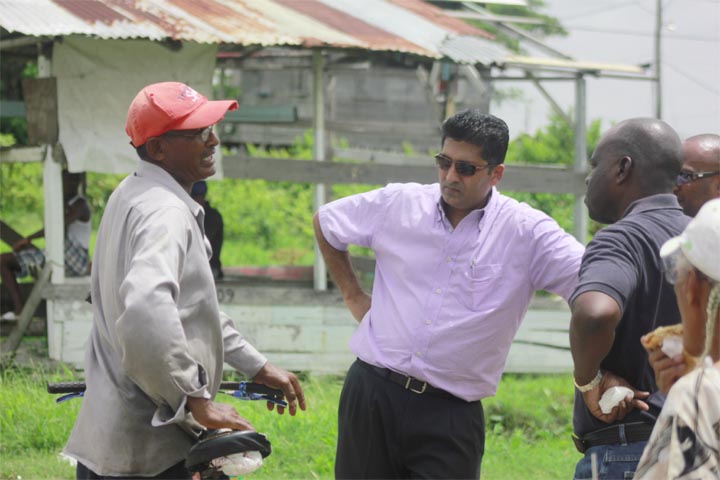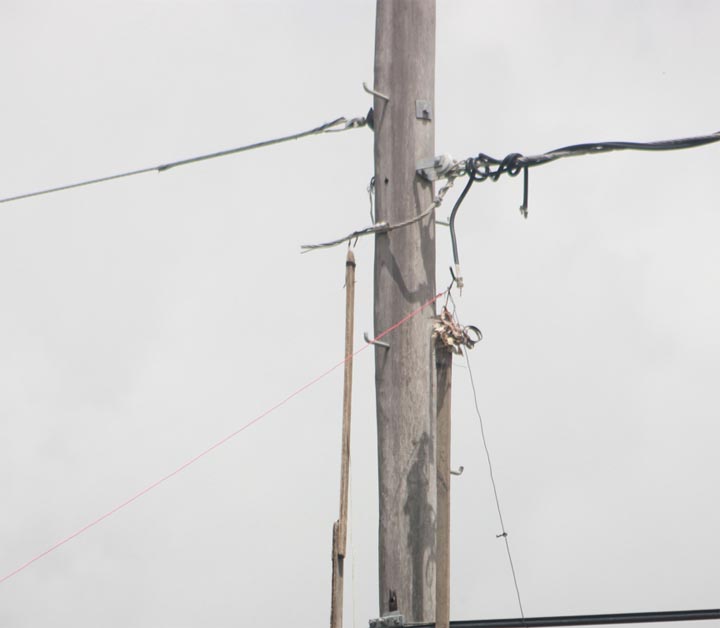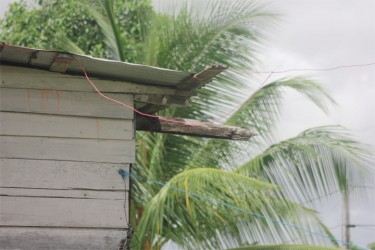Long under fire for not reducing losses, the Guyana Power and Light (GPL) yesterday touted the reduction in electricity theft by 80% in Cummings Park through a US$5 million pilot project that has seen the installation of prepaid meters and a significant increase in paying customers.
The company’s director of Loss Reduction Kumar Sharma, during a media walkabout through the Sophia community yesterday, explained that the pilot project, which was completed approximately three months ago, seeks to build a network where there is no secondary distribution (medium voltage) network, and therefore no scope for electricity theft. He said that he did not inform most residents of yesterday’s trip since they would have hidden the illegally connected wires which can still be seen in some areas.

During interviews with Stabroek News, residents expressed varying views on the project.
Sharma stated that most of the illegal extraction of power was done off the “open wire” secondary distribution network. As such, he said, this network has been removed leaving only the high voltage wires which carry 13.8 kilovolts. In addition, the company installed pre-paid meters to households who satisfied all requirements.
“It can kill you,” Sharma said, speaking about the high voltage wires. He explained that residents would risk life and possessions attempting to steal from these high voltage wires since the current is too high and will most likely overload electric appliances, or even cause death. “To install such a system included the removal of the larger transformers and replacing them with smaller transformers.
Residents are hooked up directly from the transformers and not the open conductors so they cannot extract power illegally,” he explained.
The project began in 2006/2007 after engagements between community members and Prime Minister Samuel Hinds on the issue of the provision of electricity culminated in the “Unserved Areas Electrification Pro-gramme.” The program, which was funded by government and carried out by GPL, saw the installation of a distribution network in the community. Sharma said that each household was required to pay a $10,000 capital contribution before the network, in its entirety, could be activated.

The GPL official said that some people could not pay the fee while others did not want to pay the fee, preventing the activation of the network in its entirety. As an alternative, the company sought to activate the network street by street. This also failed as residents continued to resist the initiative, and Sharma said that the company began to see the number of illegal consumers climb and a decreasing number of legal consumers.
He said that the customers who wanted to benefit from legal electricity were being held at ransom by those who insisted in maintaining their illegal connections.
In 2011, GPL, through a US$5 million loan from the Inter-American Development Bank (IDB) launched a pilot project at Cummings Park in an effort to alter the distribution network. One of the conditions of the loan was that the company engages residents before any capital or rehabilitative works were undertaken.
These innovations led to the significant reduction in thefts, according to Sharma. “As a result of this system we’ve seen a drastic reduction in the number of cases of illegal connection in the area,” he said adding that there was also an increase in the number of applications for legal connections.
The GPL official added that because of the engagements, residents were very supportive of the works being done. Several residents, who engaged reporters and Sharma during the walkthrough, expressed their appreciation of the initiative though there were some mixed feelings.
One man, Elton Gittens, said that he is satisfied with his new pre-paid meter. Gittens, who explained that he was previously without electricity, said that $1000 lasts him more than a month because of his consumption practices. Whenever he leaves home, he turns off his appliances, he explained.
Another resident, Godfrey Eastman, while praising the efforts of GPL, said that he has not received a meter and electricity since making payments about three weeks ago. The man said that he operates a shop and is waiting on electricity to run his business more efficiently. Eastman said that he approached the company on several occasions but his problem was not rectified.
Partick Uzannah, another resident, said that the company is placing braces for the utility poles in persons’ yards, preventing them from fencing their land. Uzannah said that in one instance, GPL contractors even jumped the fence of a woman who was not at home to install the brace. He said that while he welcomes the efforts of the company, they need to be more professional.
Several residents also lamented their neighbours’ insistence on maintaining their illegal connections. “We fed up of this thing man, it going on too long, when yuh tek one step forward, they bringing yuh ten steps backward, but we gon do something about it,” one woman said. The woman, who asked not to be named, said that she believes a neighbourhood council should be appointed to speak with illegal consumers about applying for legal connections.

Despite their achievements, Sharma admitted that a number of illegal connections remain. In light of the removal of the secondary distribution network in Cummings Park, some of its residents have run wires to a neighbouring community to maintain their illegal supply of power. As members of the media navigated the community, wires were seen slung from utility poles to houses; many were run across roads and even through trenches. One woman said that while she would like to pay the $10,000 fee, she was unable to do so because she just does not have the money.
Nevertheless, Sharma said that the number of illegal connections which currently exists pales in comparison to previous numbers. The project’s success rate is so great that the company has intentions of carrying out similar projects in other communities where illegal connections continue to be a significant problem. He said though, that the current projects need to be given some more time (approximately one year) so as to produce a better depiction of how effective the changes are.
 As the company continues to search for ways to reduce its losses, Sharma yesterday announced that in another pilot project aimed at reducing losses, GPL will be bringing smart metering to Guyana with the introduction of the AMI meters. These meters allow for internet monitoring of meter information by the company as well as consumers and also allows for disconnection and reconnection from the company’s office. 2000 of these meters will be installed at businesses and residences in the central Georgetown area when the program is launched later this year, he said.
As the company continues to search for ways to reduce its losses, Sharma yesterday announced that in another pilot project aimed at reducing losses, GPL will be bringing smart metering to Guyana with the introduction of the AMI meters. These meters allow for internet monitoring of meter information by the company as well as consumers and also allows for disconnection and reconnection from the company’s office. 2000 of these meters will be installed at businesses and residences in the central Georgetown area when the program is launched later this year, he said.





